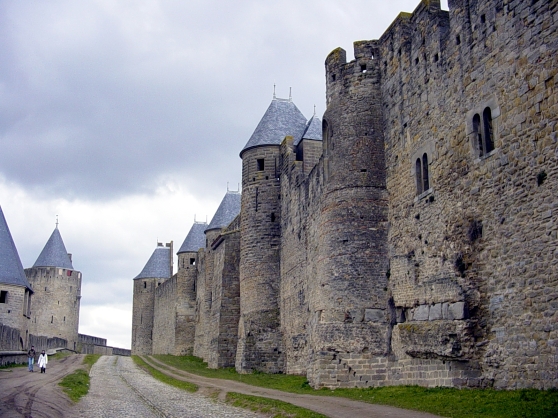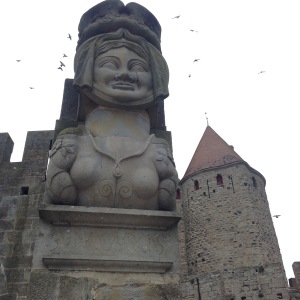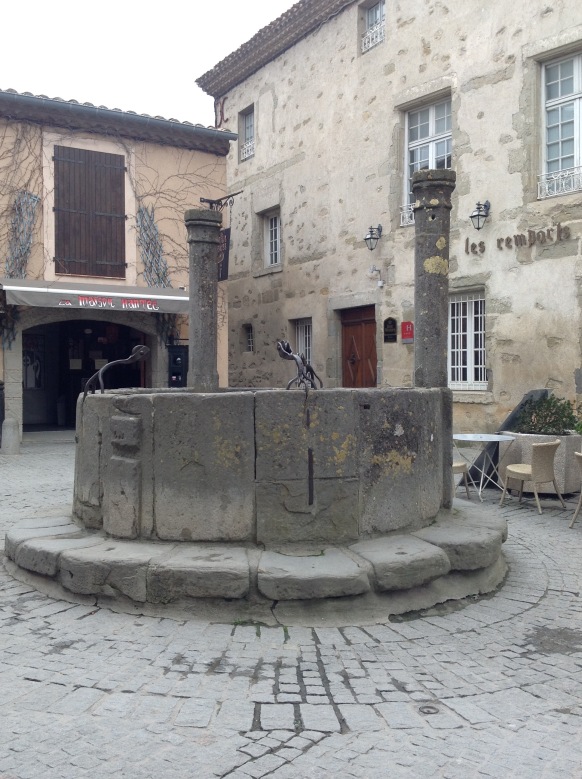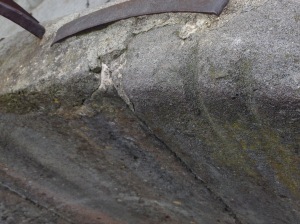
It’s from a song in the late 1800s by Gustave Nadaud, and translates to “you mustn’t die without having seen Carcassonne.”
Even after living here for over a decade, I still am overwhelmed by the sight of la Cité of Carcassonne. It doesn’t look real. It’s too big, too much like a fairytale fortress brooding atop a hill, its crenellated walls spiked by 52 towers.
I still instinctively crane for a look at it every time I pass familiar spots that offer amazing vistas of la Cité.
Approaching from the center of town over the Aude River or from the D342 near the hospital (both the new site and the old one), you have a sweeping view of the biggest intact fortified medieval city in Europe. This is a citadel as Disney would have built it.
In fact, the 1991 Kevin Costner vehicle “Robin Hood: Prince of Thieves,” among other movies, were filmed there. But la Cité’s purpose was war, not entertainment. Most of the fortress you see today was built in the 12th century atop a Roman fortified town from the 3rd and 4th century A.D. That, in turn was built on a Gallic settlement that dates back to the 6th century B.C.
La Cité draws some two million tourists a year, most of whom stay for only a couple of hours. Its walls are only about a kilometer long, and the enclosed city is about 500 meters across at the most. The main street is lined with souvenir shops and historically inaccurate “museums” that are nothing more than tourist traps. Its leafy main square, Place Marcou, is filled with tables spilling out from the surrounding cafes—lively but lousy food. But I love la Cité for its history, its surprises, its hidden treasures.

After you cross the drawbridge, on the inner rampart to the left you can see the layers of different stones and bricks. Its many invaders include the Romans, the Visigoths, the Moors and even other Frenchmen. At one time, some 4,000 people lived there—hovels even occupied the space between the walls—but today only a couple dozen residents, or citadins, remain.

Carcassonne was sat on the trade route between Bordeaux and Rome, making it a key takeover target. The most-repeated tale is of the Saracen, or Moorish, princess Dame Carcas, who resisted a siege by Charlemagne. Her people starving in the citadel, she ordered all the remaining food to be rounded up—a pig and some beans. She had the pig stuffed with the beans, and tossed over the wall at Charlemagne, who decided this dame was so crazy he would get away while he could. As the French retreated, the fortress bells rang, hence “Carcas sonne.”

Unfortunately for the story, Charlemagne never attacked Carcassonne; it was his father, Pepin the Short, and he didn’t withdraw but won the battle, sending the Saracens back to Spain. For those who prefer the fairytale, Dame Carcas is also credited with inventing cassoulet, the signature dish of French country cooking, whose ingredients include white beans, pork, duck and sausage.
What is amazing about la Cité is how–despite the crush of visitors, who rightly made a special trip or at least a detour to see it–the little streets that have no shops or restaurants are often empty. Le Saint-Jean café-restaurant at the back of the Château Comtal (the count’s castle within the fort, now a must-see museum) has a fantastic view, and I’ve never seen more than one or two other tables occupied when I stop there, because it’s so hidden away.


Other treasures are hidden in plain sight, like the 14th century Tree of Jesse stained glass window in the Saint Nazaire basilica that shows Jesus’s family tree. Or the rope marks on the lips of la Cité’s two wells–everybody climbs up to look over the side … at nothing; the wells are closed. I like to run my fingers over the grooves made by centuries of ropes and think how the former residents pulled up their water by bucket from the depths. Like so much in this region, the modern world tries to invade, but in the end, Languedoc resists change and wins.
Here’s a link to Georges Brassens singing “Carcassonne,” though it inexplicably is accompanied by pictures of Cadaques, Spain. http://bit.ly/1KNss2o

I wonder how the 2M visitors figure was calculated? That would put it up on a par with Mont St Michel for visitor numbers and make it the second most visited heritage attraction outside of Paris (Versailles is first). However, I was under the impression that MSM was second and Chenonceau was third, with 900 000 visitors.
LikeLiked by 1 person
Good question. I got that from the tourism office. I see Lonely Planet is claiming 4 million, but doesn’t give a source.
LikeLike
According to Atout France the Cité de Carcassonne got 538 115 visitors in 2015. Figures here. That makes it about 7th on the list of most visited historic monuments outside of Paris (ie as opposed to museums and other miscellaneous sites). Versailles is first with 5.8M, then MSM at 1.25M, the Basilica at Vézelay 856K, Chenonceau with 850K, Chambord 783K, Palais des Papes at Avignon 641K. The 2M figure must reflect a broader definition of visiting Carcassonne and I can’t work out where it’s come from. In any case, any visitor numbers over about 350K for a historic site is off the scale and more or less unmanageable in terms of the long term protection of the site in my experience.
LikeLiked by 1 person
Carcassonne gets lots of daytrippers (especially from the beach; too bad for them, missing out on more; just the fireworks bring in a crazy huge number, supposedly the second-biggest after Paris). The 538K number sounds like the figure for the château/museum inside la Cité. On the whole, la Cité, and then Carcassonne more generally are much bigger geographically than the places you note.
LikeLike